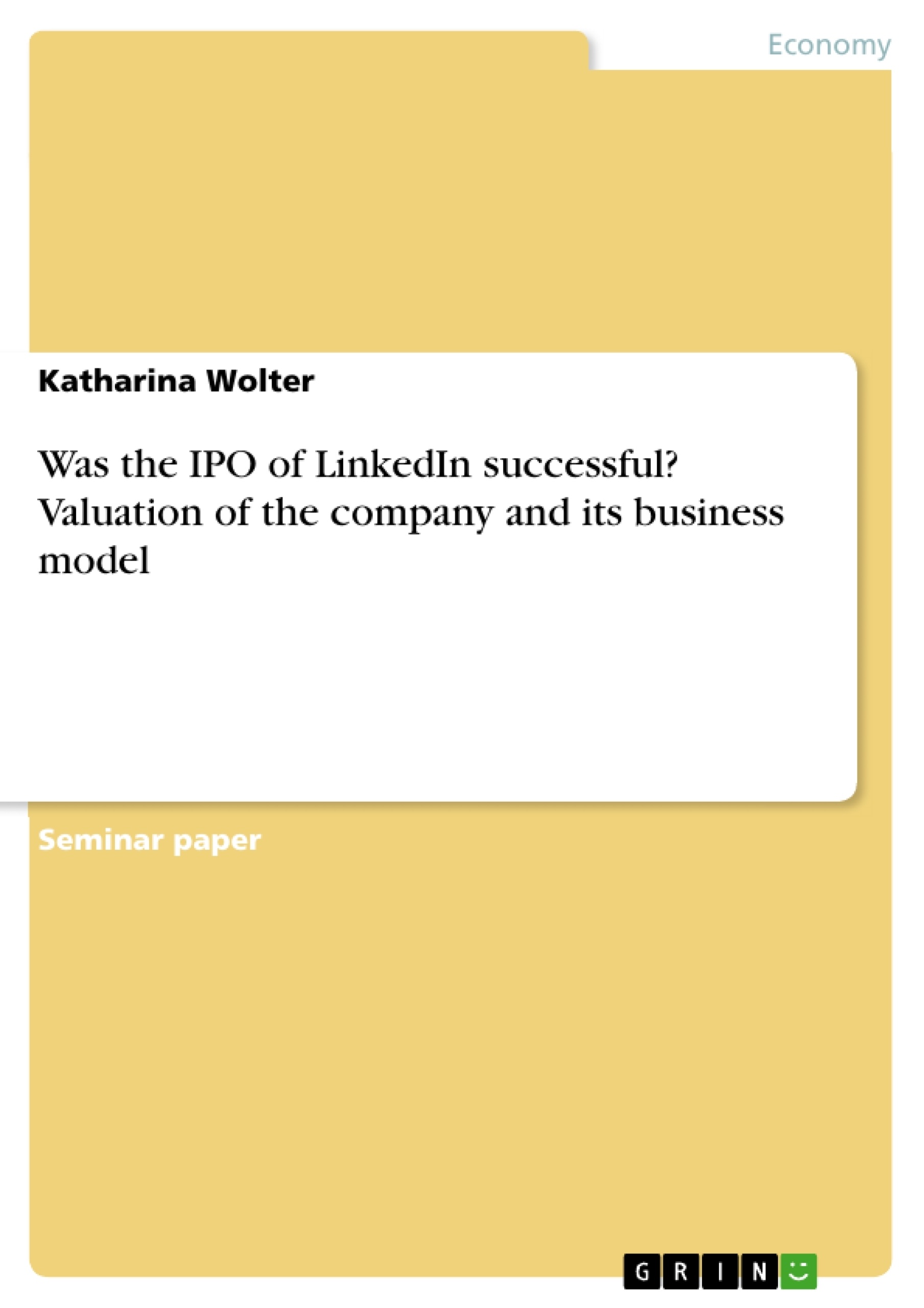This paper explores LinkedIn’s business model (including opportunities and threats), as well as the corporation’s competitive landscape and the details of the initial public offering (IPO). In this paper different approaches to assess a company value will be discussed, followed by an examination of LinkedIn’s company value by carrying out a multiple analysis. A special emphasize will be taken on the closing price for LinkedIn shares on the IPO (and also a few weeks later on July 7, 2011), were the company was worth 592 times its 2010 earnings. The research evaluates if the company could possibly be worth that much or if a general hype for social media company´s has taken over.
Why and to what extent, an IPO is successful, lies always in the opinion of the different stakeholders of this event. Obviously there are two main stakeholders: the company owners and the investors. For company owners, an IPO will be about developing their company to the next stage. Raising new capital for investment, attracting and incentivizing the best talent, and establishing a liquid currency for the future. For them, valuation1 at IPO and a healthy aftermarket with a steady appreciation in the value of the shares as the company develops, will be key.
For investors obviously an IPO is successful, if the share price is going up, not down. But since nobody can tell that for sure, how do you decide if you invest your money at an initial public offering of a certain company? There are various ways to do that, some people decide just to go with the flow, jumping on a train that’s already under full force (e.g. dot.com hype). Other will do an extended research for the opportunities, growth potential and threats of the business model, as well as the possible competitors and challenges they will face in the future. Some, on the other hand, will go for the figures and financial analyses. Since there is a saying “the only statistics you can trust are those you falsified yourself” (mostly allocated to Winston Churchill, but not verified), it seems logical to build the decision on all three factors.
Inhaltsverzeichnis (Table of Contents)
- LinkedIn's Business Model at the Time of the IPO.
- Hiring Solutions.
- Marketing Solutions
- Premium Subscriptions
- LinkedIn's Opportunities and Threats at the Time of the IPO.
- Opportunities.
- Threats.
- LinkedIn's Competitive Landscape at the Time of the IPO.
- Analogs
- Job Boards/Online Recruitment
- Social Media Networking/Search Engines.
- LinkedIn's Company Value - Multiple Analysis
- EV/EBITDA.
- EV/Sales
- EV/User.
- LinkedIn's IPO – Brief Details
- Facts
- Rumors
- LinkedIn's Share Value - July 7, 2011.
Zielsetzung und Themenschwerpunkte (Objectives and Key Themes)
The paper aims to analyze LinkedIn's business model, competitive landscape, and the details of its initial public offering (IPO), particularly examining the valuation of the company at the time of the IPO. The research assesses whether the company's valuation was justified or if it was driven by a general hype for social media companies.
- LinkedIn's business model and its revenue streams at the time of the IPO.
- The opportunities and threats faced by LinkedIn in its competitive landscape.
- The evaluation of LinkedIn's company value using multiple analysis techniques.
- The details of LinkedIn's IPO and the factors influencing its share value.
- An analysis of whether LinkedIn's valuation at IPO was justified.
Zusammenfassung der Kapitel (Chapter Summaries)
The paper begins by introducing LinkedIn's business model, which centers around connecting professionals through their personal and professional profiles. The platform offers various features such as job searching, networking, and business opportunities. LinkedIn's revenue streams are generated through hiring solutions, marketing solutions, and premium subscriptions. The paper explores LinkedIn's opportunities and threats at the time of the IPO, including the growth of the professional networking market, competition from other social media platforms, and challenges related to user privacy and data security.
The paper then delves into LinkedIn's competitive landscape, comparing it to similar platforms such as job boards, online recruitment services, and social media networks. It explores the key differentiators of LinkedIn, such as its focus on professional networking, access to passive job candidates, and its unique data insights. The paper continues by examining LinkedIn's company value using multiple analysis techniques, including EV/EBITDA, EV/Sales, and EV/User, to assess the company's financial performance and market positioning.
The final section of the paper focuses on the details of LinkedIn's IPO, including the key facts and rumors surrounding the event. It explores the factors that influenced the IPO price, the market response to the IPO, and the subsequent performance of LinkedIn's shares. The paper concludes by analyzing whether LinkedIn's valuation at the IPO was justified, considering its growth potential, competitive landscape, and the general market sentiment towards social media companies.
Schlüsselwörter (Keywords)
The paper explores key concepts related to LinkedIn, its IPO, and valuation methodologies, including LinkedIn, initial public offering (IPO), multiple based valuation analysis, social media, business model, competitive landscape, opportunities, threats, revenue streams, and company value.
- Citation du texte
- Katharina Wolter (Auteur), 2016, Was the IPO of LinkedIn successful? Valuation of the company and its business model, Munich, GRIN Verlag, https://www.grin.com/document/346955



